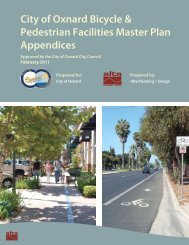Santa Clara River Trail Final Master Plan - Development Services ...
Santa Clara River Trail Final Master Plan - Development Services ...
Santa Clara River Trail Final Master Plan - Development Services ...
Create successful ePaper yourself
Turn your PDF publications into a flip-book with our unique Google optimized e-Paper software.
<strong>Santa</strong> <strong>Clara</strong> <strong>River</strong> <strong>Trail</strong> <strong>Plan</strong><br />
Figure 6. Concrete <strong>Trail</strong> Cross-Section 3<br />
Use of Recycled Concrete Aggregate (RCA)<br />
RCA is granular material manufactured by removing, crushing, and processing hydraulic-cement<br />
concrete pavement for reuse with a hydraulic cementing medium to produce fresh paving concrete.<br />
Except for removing steel, impurities, and contaminates, this process is identical to the process used to<br />
produce aggregate from virgin stone materials. Adding RCA to concrete pavement may reduce costs,<br />
depending on availability of RCA vs. virgin stone materials. 4<br />
Fly Ash<br />
Fly ash is a fine, glass-like powder recovered from gases created by coal-fired electric power generation.<br />
U.S. power plants produce millions of tons of fly ash annually, which is usually dumped in landfills. Fly<br />
ash is an inexpensive replacement for Portland cement used in concrete, while it improves strength,<br />
segregation, and ease of pumping of the concrete. The techniques for working with this type of concrete<br />
are standard for the industry and will not impact the budget of a job.<br />
Use of Pervious Concrete<br />
Pervious concrete allows rain to seep through the surface and percolate into the soil reducing run-off.<br />
The water is never trapped as it is on normal concrete paving. The use of pervious pavement systems<br />
attenuates the peak discharge of storm water into drainage systems. Pervious concrete lasts for<br />
approximately 15 years and requires a sweep and pressure wash four times per year to maintain<br />
percolation.<br />
3 Note: The “c le ar” shoulde rs shown on the cross-section should be kept emp ty of buildings or fences; however, low-lying vege tation or bioswale plantings<br />
are encouraged in these areas. Depth of subbase should be determined by a soil analysis.<br />
4 Additional information available at: http://www.fhwa.dot.gov/pavement/t5 04037.cfm<br />
City of Oxnard | 73
















